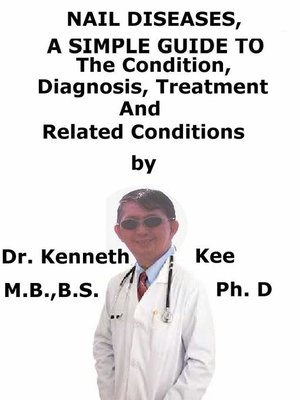Nail Diseases, a Simple Guide to the Condition, Diagnosis, Treatment and Related Conditions
ebook
By Kenneth Kee

Sign up to save your library
With an OverDrive account, you can save your favorite libraries for at-a-glance information about availability. Find out more about OverDrive accounts.
Find this title in Libby, the library reading app by OverDrive.



Search for a digital library with this title
Title found at these libraries:
| Loading... |
This book describes Nail Diseases, Diagnosis and Treatment and Related Diseases
"The nails are dangerous in the wrong hands (pun intended)."
The nails are to women like what claws are to animals.
The sharp fingernails can literally claw the eyes out or cut the skin of the face.
The nails are present at the end of each finger tip or toe tip on the dorsal surface.
The main function of nail is:
1. Protection
2. A firm grip for holding articles
3. The indispensable one of picking up small things.
The normal healthy nail is slight pink in color and the surface is convex from side to side.
It comprises:
1. A strong relatively flexible keratinous nail plate which begins from the nail matrix.
Keratin is the structural material making up the outer layer of human skin.
2. Under the nail plate is a soft tissue called nail bed, the covered part embedded in the skin
3. Between the skin and nail plate there is a nail fold or cuticle.
4. The nail wall (paronychium) is the skin covering the root and sides of the nail.
5. The lunala is the white section at the base of the nails.
Since the body of the nail is transparent the blood reveals through and gives it a pinkish hue.
The nail plate is the largest part of the nail unit.
The nail matrix produces the nail plate.
Any defect to the matrix may cause onychodystrophy of the growing nail plate.
The proximal nail matrix forms the dorsal part of the nail plate while the distal matrix forms the ventral part of the nail plate.
Cells in the stratum germinativum (growing part of skin at the base of the nail or matrix) fuse with cells of the root of the nail and push the older cells away so that the nail seems to be growing.
The dead cells of the nail form the horny part of the nail.
The nail grows at the rate of one tenth of a millimeter daily for finger nails and about half that rate for the toe nails.
While the area of the stratum germinativum or matrix is intact, a nail that is torn off will regenerate.
The growth of nail is affected by disease:
1. Nail shedding
2. Nail biting
3. Malnutrition.
Nail Diseases
Nail disorders make up about 10 percent of all skin conditions.
Nail disorders normally rise throughout life and involve a high number of senior citizens.
Symptoms that could signal nail disorders are color or shape changes, swelling of the skin around the nails, thinning or thickening of the nails, bleeding or discharge, and pain.
Nails often indicate the general state of health.
Alterations in the nail, such as discoloration or thickening, can signal health disorders, such as liver and kidney diseases, heart and lung disorders, anemia and diabetes.
Fungal infections produce about 50% of all nail disorders.
While rare, melanomas can grow under the nail.
Other frequent nail problems are:
1. White spots appear after an injury to the nail.
2. Vertical lines, known as splinter hemorrhages, under the nails that are caused by nail injury or certain drugs or diseases.
3. Bacterial infections, which are most often due to injury, poor skin hygiene, nail biting, finger sucking, or frequent exposure to water.
4. Ingrown toenails, which are caused by improper nail trimming, poor stance, digestive problems, or tight shoes.
A. Onychia is the inflammation of the nail folds of the nail with production of pus and shedding of the nail.
B. Chronic Nail diseases
1. Fungal Infections
a. Candidiasis
b. Onychomycosis
2. Paronychia
3. Melanonychia
4. Distal onycholysis
5. Subungual...






